What lies beneath the new Jaguar XF’s seductive exterior
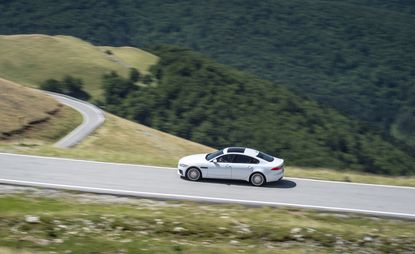
It is near impossible not to be seduced by Jaguar’s latest creation, given the launch setting of Pamplona and the Navarran Pyrenees in northern Spain. This expansive and hugely dramatic landscape, with its empty roads that snake high into the lush green uplands, pockets of grazing cows and sheep, wild horses and the occasional bull in the distance, makes for quite a setting. This part of the country can help create a compelling story for most vehicles, yet the XF almost ‘owned’ these silent roads.
The experience was made complete with a teaser at the Circuito de Navarra track where we were briefly let loose. Few such standard road cars can handle this challenging racing circuit, yet the light, aerodynamic, agile XF does so with apparent ease. This is a car essentially destined for a more demure life as a company vehicle and it is precisely this kind of juxtaposition that has come to distinguish Jaguar from its more cautious rivals. It is the marque’s charm.
This is the second-generation XF – the company was undergoing a huge transformation when the initial car was introduced in 2007. As an entry-level Jaguar, its task then was to court new customers and debut a distinct new design language. The swooping coupé roofline, compact body and a bold interior that played with the digital and craft world succeeded in presenting a new, confident marque. Eight years on, and with a small XE in production, it was also time for a new XF.
At the heart of the car is the firm’s new lightweight modular architecture. The design team worked closely with engineering to harness this and conceive a vehicle that is lighter yet stiffer, highly aerodynamic and more compact in proportion – yet roomier inside.
At 4,954mm the XF is 7mm shorter and 3mm lower than the previous model, yet the reduced front overhang and stretched wheelbase has allowed for 15mm more legroom and up to 27mm more headroom. The car also boasts exceptionally low aero drag of 0.26cd, achieved through a range of small design tweaks.
The fusion of light aluminium for the body panel and a mix of high strength steel in key structural areas (and the all-aluminium suspension set-up) means the car is now 190kg lighter than the outgoing model, improving fuel economy and CO2 emissions figures.
This is evidently an evolution in design, exploring the distinct silhouette of the original model while introducing a more vertical assertive mesh grille, shorter front overhang and a distinctive power bulge that now runs all the way up the elegant long bonnet.
Jaguar director of design Ian Callum points to the waistline, which sits at a more horizontal level on the new car: ‘the strongest element visually,’ the design director notes. ‘We’ve worked very hard to create a shoulder line that is much more elegant, stronger yet relaxed, in many ways, sitting underneath the window graphic of the car,’ he says, explaining how it has been essential in tying the whole sculpture together.
There are extra ‘sixth light’ rear windows, which, coupled with the optional panoramic sunroof, really improve the feeling of spaciousness in the cabin. The rear has a distinctive look too, with an interpretation of the LED tail lights first featured on the F-Type. Together with a rather lovely chiselled boot line, they visually connect the XF with its sportier sibling.
‘One of the things that is great about the interior is the theatre of it,’ muses Callum. Thus, he has retained the tactile metal rotary shift control and rotary air vents that spin open when you turn the engine on. ‘It’s a wonderful moment when they spin up to say hello to you. It gives you that sense of occasion.’
The interior continues Jaguar’s quest to marry traditional design and craft with the modern age. This is a hugely connected car, highly digital yet at the same time offering decent levels of quality and craftsmanship – and plenty of tactile surfaces. Soft leather, warm wood and shiny chrome elements are abundant, and the new seats are pretty comfortable, almost gripping us on the Navarra circuit.
There is a reconfigurable TFT instrument cluster and a 10.2-inch touch screen containing all the infotainment and entertainment information, 17-speaker, 825W Meridian digital surround sound and bold laser head-up display.
The layered instrument panel now swoops the width of the car, merging into the doors and emphasised by singular stitching featuring the marque’s signature Riva Hoop design, first introduced on the XJ. There is certainly a sense of lightness inside the new XF; it feels hugely more spacious, especially in the rear compartment.
Jaguar has simplified the engine range to include a 3.0-litre supercharged V6 – with 375bhp and available in the top of the range S trim – with a 5.0-litre supercharged V8 expected at a later stage. At the top of the diesel range sits the 3.0-litre V6 tweaked to deliver some 296bhp, and the 2.0-litre Ingenium diesel engine that comes with 178bhp and 161bhp, the latter emitting what the marque says is the lowest CO2 figures in this class at just 104g/km.
The business car sector is a crowded one and choice is often made according to less sexy values, such as running cost and tax. Yet the individuality based on intelligent design and that element of surprise that the XF holds will no doubt appeal to those looking to stand out in the sea of grey suits.
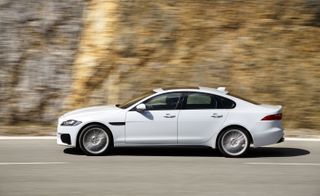
This is the second-generation of the model – the company was undergoing a huge transformation when the initial car was introduced in 2007. Eight years on, and with a small XE in production, it was also time for a new XF
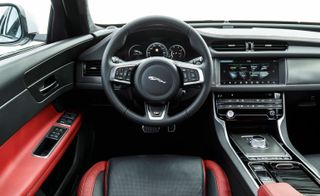
Inside, the layered instrument panel now swoops the width of the car, merging into the doors and emphasised by singular stitching
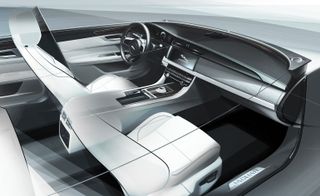
It's also roomier inside – the XF is 7mm shorter and 3mm lower than the previous model, yet the reduced front overhang and stretched wheelbase has allowed for 15mm more legroom and up to 27mm more headroom
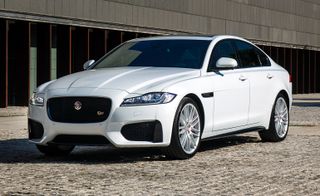
At the heart of the car is the firm’s new lightweight modular architecture – the design team worked closely with engineering to harness this and conceive a vehicle that is lighter yet stiffer, highly aerodynamic and more compact in proportion

The rear has a distinctive look too, with an interpretation of the LED tail lights first featured on the F-Type
Wallpaper* Newsletter
Receive our daily digest of inspiration, escapism and design stories from around the world direct to your inbox
-
 Gucci’s ‘Design Ancora’ reimagines furniture classics in rich red
Gucci’s ‘Design Ancora’ reimagines furniture classics in rich redGucci launches new editions of Italian design icons in an alluring deep red, showcased during Milan Design Week 2024
By Simon Mills Published
-
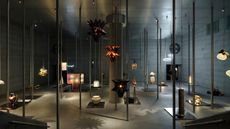 Loewe’s Jonathan Anderson drafts artists to create 24 extraordinary lamps at Milan Design Week 2024
Loewe’s Jonathan Anderson drafts artists to create 24 extraordinary lamps at Milan Design Week 2024Loewe creative director Jonathan Anderson commissioned international artists and artisans to explore ‘illumination within the house’ with a series of lamps and lighting installations, shown at a group exhibition at Milan Design Week 2024
By Scarlett Conlon Published
-
 What are polynucleotides? Trying the skin injectable made from salmon sperm
What are polynucleotides? Trying the skin injectable made from salmon spermPolynucleotides are the latest in skin injectables, containing DNA derived from the gonads of salmon. Wallpaper* Beauty & Grooming Editor Hannah Tindle tries them to discover exactly how they work
By Hannah Tindle Published
-
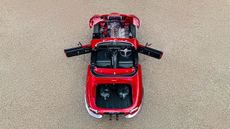 Helm’s meticulously re-imagined Jaguar E-Type features a finely crafted interior by Bill Amberg
Helm’s meticulously re-imagined Jaguar E-Type features a finely crafted interior by Bill AmbergHelm transforms the legendary E-Type into a thoroughly modern machine, upgrading every aspect of Jaguar’s pioneering sports car to an exacting brief
By Jonathan Bell Published
-
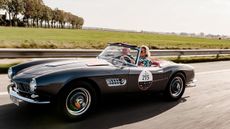 Zoute Grand Prix is a car fest like no other at a pristine Belgian beachside town
Zoute Grand Prix is a car fest like no other at a pristine Belgian beachside townAmy Serafin takes to the well-heeled streets of Knokke-Heist to experience the Zoute Grand Prix, its annual cavalcade of classic car-related events, from a rally to an auction
By Amy Serafin Published
-
 Jaguar F-Type 75 special edition is the last of its kind as the marque hints at a radical future
Jaguar F-Type 75 special edition is the last of its kind as the marque hints at a radical futureThe Jaguar F-Type 75 will be the last ever V8-powered Jaguar; is it also the end of conventional sports cars for this legendary British marque?
By Jonathan Bell Published
-
 Peugeot’s sparky 308 gets hybrid power and handsome lines
Peugeot’s sparky 308 gets hybrid power and handsome linesThe Peugeot 308 proves that mass-market design needn’t be dull, blending hybrid power with sharp lines and excellent detailing
By Jonathan Bell Published
-
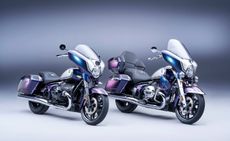 BMW Motorrad brings out the big guns for its newest cruisers
BMW Motorrad brings out the big guns for its newest cruisersBMW Motorrad R 18 Bagger and Transcontinental set the tone for high-voltage cruising with a brand collaboration with speaker specialist Marshall
By George Chapman Last updated
-
 Dacia’s new Manifesto concept is a true outdoor utility vehicle
Dacia’s new Manifesto concept is a true outdoor utility vehicleUtilitarian auto brand Dacia sets a bold new agenda with its Manifesto, a concept car pitched at the active outdoor market
By Jonathan Bell Last updated
-
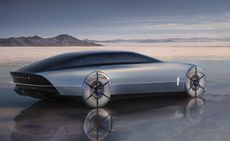 The sun sets on traditional supercars at California’s Monterey Car Week
The sun sets on traditional supercars at California’s Monterey Car WeekMonterey Car Week, the world’s most prestigious car gathering, is showcasing ever-more extravagant special editions, coachbuilt cars and all-new electric concepts. Here are seven key machines from 2022
By Rory FH Smith Last updated
-
 Is McLaren’s GT a sports car, a tourer, or the best of both?
Is McLaren’s GT a sports car, a tourer, or the best of both?The McLaren GT is a capable all-rounder dressed up in svelte supercar clothes. It might also be the last of its type
By Jonathan Bell Last updated